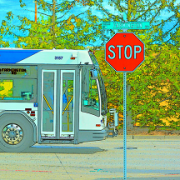Burney Simpson
The only trend moving faster than driverless transportation this August is Bernie Sanders.
This last week saw major interest in the autonomous vehicle industry, first with the Guardian breaking the news that Apple is seeking to use the driverless test track in Contra Costa, Calif., and, second because a Morgan Stanley analyst predicted that Tesla’s stock could nearly double in value, primarily because of its potential driverless technology.
Now, August can be a slow news month. But since when did vehicle test tracks become major clickbait?
The Apple story brought new life in the media to the battle between Michigan’s Mcity and California’s GoMentum Station. (See “Driverless Car Testing to Expand at Contra Costa,” March 20, 2015).
WEST COAST VS MIDWEST VS SOUTH
In brief, that’s the competition between the solid but dull Midwesterners and the creative but out-there Silicon Valley-ites. The next big angle is Virginia Tech’s track in Blacksburg, so we can learn about the hard-driving but backward good ol boys. (See “Va Tech Leaves ‘Em Eating Its Dust in Race to be the Top Driverless Test Track,” June 7, 2015)
A quick question — didn’t test tracks used to mean a bunch of sweaty guys jotting down notes on a clip board? Now it’s tattooed millennials tip-tapping into tablets.
The Guardian obtained secret documents that show, supposedly, that Apple is ready to spend some of the $200 billion it has in the bank, and it wants to become a car company.
Apple has been looking into reserving space at the GoMentum test track, the 5,000-acre site with 20-some miles of roads that Honda and Mercedes have been using in the last 12 months. Apple likes the fact that GoMentum has barbed wire fences and security guards with guns, claims the Guardian, because the firm is very secretive and their headquarters are in the area anyway, and they need to use that talent they’ve been poaching from competitors.
By the way, the Apple project is “codenamed Project Titan,” the Guardian reports, and it is led by Professor Charles Xavier. (No, we just made that up, the professor part. But it is called Project Titan.)
ELECTRIC DRIVERLESS RIDE-SHARING
Meanwhile, Tesla may be working on marketing an electric, driverless-vehicle ride-sharing service directly to consumers, according to Morgan Stanley’s Adam Jonas. This builds on the comment a few months ago by an Uber executive that the cab company would gladly buy half a million driverless cars from Tesla if only the electric car OEM were to make them.
The Tesla theorizing actually takes the futuristic aspect of driverless vehicles to the next logical stage, which is using an engine that reduces the use of fossil fuels.
![TeslaStore1]() Currently, much of the power used to recharge Tesla’s electric cars is generated by plants burning coal and oil. But let’s look down the road about 10 or 20 years. Perhaps by then solar and wind will have displaced coal/oil as the principal fuels generating the power we will use to charge our driverless vehicles.
Currently, much of the power used to recharge Tesla’s electric cars is generated by plants burning coal and oil. But let’s look down the road about 10 or 20 years. Perhaps by then solar and wind will have displaced coal/oil as the principal fuels generating the power we will use to charge our driverless vehicles.
Under Jonas’ concept, Tesla will make a driverless electric vehicle, then build and operate a mobility service using these creations, cutting out such middlemen as Uber and possibly local mass transit systems.
This projection is similar to the study released this year by scientists at Lawrence Berkeley National Laboratory that a self-driving, electric taxi could reduce operating costs and produce 90 percent lower greenhouse gas emissions than a 2014 gasoline-powered, privately-owned vehicle. (See “Driverless Electric Cabs Will Cut Emissions, Save Bucks: Berkeley Study,” July 21, 2015). The costs savings would come from eliminating the driver and from lower fuel and maintenance expense.
Yes, the Tesla theory is based on a lot of what ifs and assumptions. But it comes from current trends and the stated goals of western governments.
Could it happen? Who knows, but it’s a lot more interesting than a Dick Tracy watch.
Feature photo – Mini car (electric car), Milan, Italy by Dzhingarova.
Photo in story – Amsterdam: Tesla Store by harry_nl, 2014

